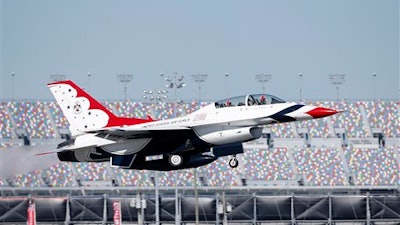
COLUMBIA, S.C. (AP) — The pilots at the controls of the two F-16 jets that collided over Georgia this week are seasoned combat veterans — and so are the jets they were flying.
The planes were built in 1993 and have flown hundreds of combat missions, including the fiery 2003 attack on Baghdad dubbed "Shock and Awe," according to commanders of the South Carolina National Guard.
The pilots were part of a six-plane unit practicing a high-tech "cat-and-mouse game" of electronic warfare at the time of the crash, said South Carolina Guard commander Maj. Gen. Robert Livingston.
"It's a specialty of this wing," the two-star general told reporters Wednesday, speaking on the tarmac where the 169th Fighter Wing is based at McEntire Joint National Guard Base.
The strategy calls for the warplanes to be the first to enter enemy territory, where they use sophisticated electronics to find and destroy an opponent's radars and anti-aircraft missile sites. This makes it safer for U.S. or allied ground troops, follow-on bombers and fighter aircraft to move forward and hit targets behind enemy lines.
Wing commander Col. Nicholas Gentile said the jets in his unit are single-pilot F-16C "Flying Falcons" built in 1993. He said they carry the technical designation "Block 52," which refers to upgrades that are designed to make them some of the most advanced F-16s in the U.S. Air Force.
In 2003, the men and women of the 169th were sent to the Middle East during the second war against Iraq. The unit flew more than 400 combat missions, including the fiery attack against Baghdad as U.S. and allied forces began the effort to topple the government of Saddam Hussein.
"The U.S. Air Force has continually upgraded its F-16s with new radars, new electronic warfare devices, better communications equipment and other devices that contribute to the aircraft's overall safety," said aerospace analyst Loren Thompson of the Virginia-based Lexington Institute think tank.
But Thompson says the Air Force is having problems paying for the continual upgrades given the budget constraints Congress has put on Pentagon spending.
"Pentagon spending by law has been capped since 2012 and most of the savings have come at the expense of weapons and technology," Thompson said. He said F-16s have been kept in "relatively good shape," but the Air Force has lost fighter jets due to structural fatigue.
For years, Air Force Chief of Staff Gen. Mark Welsh has warned about the dangers of flying aircraft that are decades older than the pilots who fly them. "Airplanes are falling apart," he was quoted as telling members of the Air Force Association in September 2014.
Both Livingston and Gentile called the pilots who survived the midair collision "seasoned" combat veterans who are lieutenant colonels and instructors with the unit. They called the unit's safety record exemplary, noting it has been 30 years since any such incident.
They declined to identify the two men and said they could not give any reasons for the crash because it was under investigation by both the Guard and the active duty Air Force.
The Georgia crash comes on the heels of another high-profile training crash.
Two Navy F/A-18 Super Hornets based in Virginia Beach crashed off the North Carolina coast in May. The four people on board the two-seater jets were plucked from the Atlantic Ocean in the wake of the crash.
The Navy jets were performing training exercises and were described as the newest models of F/A-18 warplanes.
Naval Air Force Atlantic spokesman Mike Maus said Thursday that he couldn't provide information about the age of the F/A-18s that crashed because the crash remains under investigation.






















